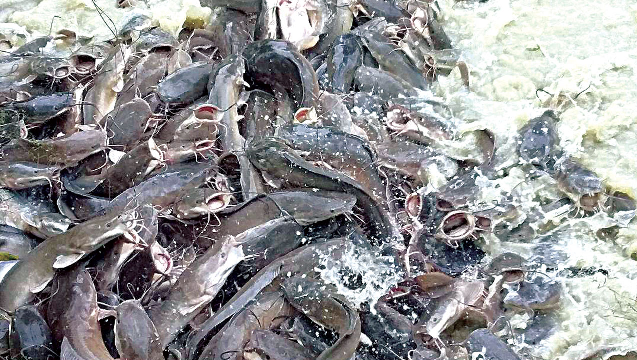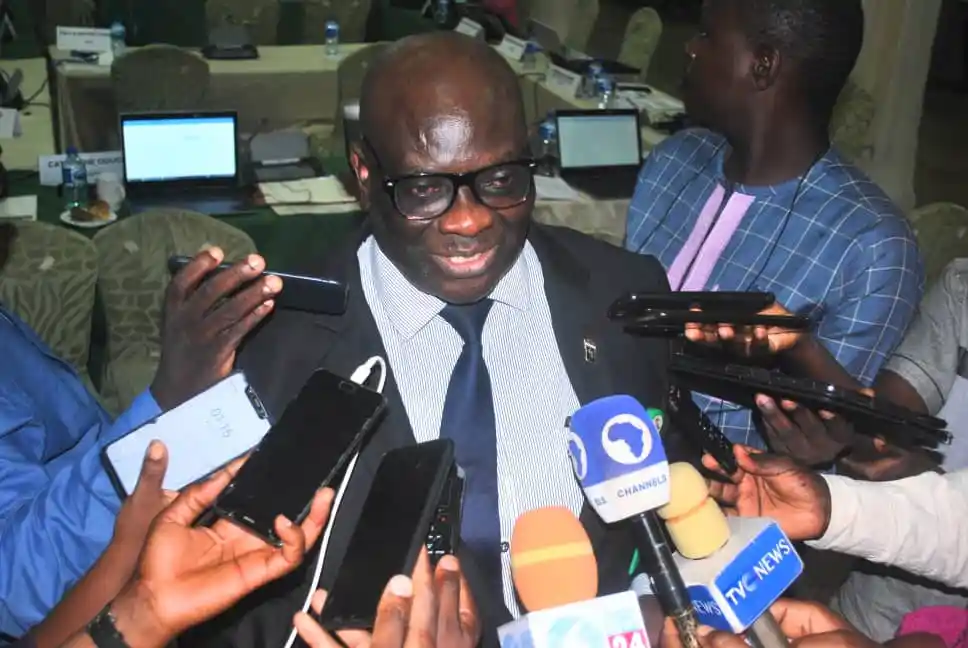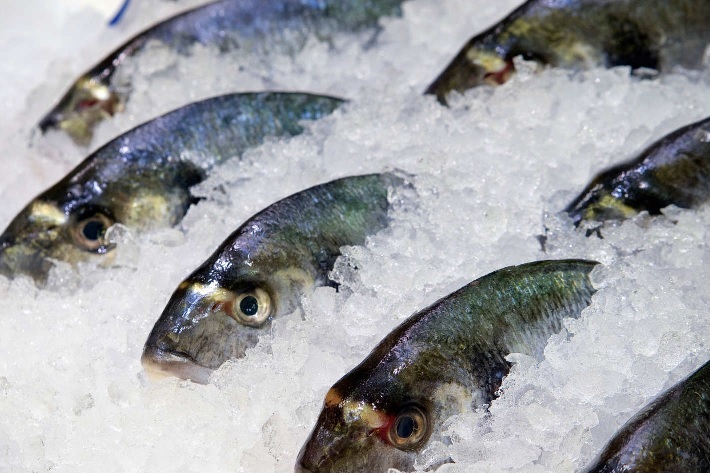The youth are an integral part of society that can drive agriculture transformation
by Judith Akolo
African Union member states are being advised to take advantage of the youth bulge and utilize them in agriculture transformation.
A Food and Nutrition systems expert Dr. Laila Lokosang says that the youth constitute the largest population on the African continent hence they posses the human capital that can aid in agriculture transformation. "Today 1.2 billion of the world population is between the ages of 15 and 24 years," he says and adds, "Africa has the youngest population with nearly 88% of them living in developing nations, particularly rural sub-saharan Africa and South-Central and South East Asia."
Speaking on the topic “Role of youth as human capital agents towards transformative and resilient agro-food systems in Africa”, Dr. Lokosang who spoke at the 13th Africa Day of Food and Nutrition Security (ADNS) said that empowering the youth through investing more in technology, digitalization, innovation, and data availability will aid in the youth in aiding agriculture transformation.
In his paper, Pathways for Leveraging the Potential of the youth in the Agro-Food Systems Transformation Agenda, at the ADNS Dr. Lokosang arugues that if the youth are allowed to play an active role in the food systems transformation agenda, this will enable the youth to leverage on and access opportunities such as green jobs across the food value chains.
The Senior Technical Advisor to the Commisioner for Agriculture, Rural Development, Blue Economy and Sustainable Environement at the African Union Commision, says that while the Malabo Declaration in 2014 set a target of creating job opportunities for at least 30% of the youth in agriculture value chain, member states are still lagging behind.
He is urging for policy interventions that ensure that their is adequate investment in digital technologies in the agriculture sector, as well as mechanisation to make agriculture attractice hence be able to attract the youth into the sector, "the youth are tech survy and their role in the sector using the digital space is of utmost importance," says Dr. Lokosang.
Among the interventions being suggested by Dr. Lokosang to be able to attract youth into the agriculture sector include; establishing mechanisms that enable the youth to be agropreneurs, incentivise and promote corporate youth-led agribusiness investment, open market opportunities for youth producers of agricultural commodities, establishe knowlege platforms and communities of practice for the youth to share experience in sucessful practice, "which will encourage fellow youth to get into agribusiness," says Dr. Lokosang, the Senior Technical Advisor on Food Systems.
Dr. Lokosang is calling for the need for member states to support the participation of women and youth in gainful agribusiness opportunties. He argues that there is a nned to make "women’s empowerment an integral part of social protection programmes," he says and adds that "Improving woman socio-economic status and educational status enhances the benefits of social protection interventions, and improves the nutritional status of the household."
View Full Post and Comments
The media globally has been asked to help raise awareness on Antimicrobial resistance (AMR)
By Judith Akolo
One of the greatest challenges is that of communicating antimicrobial resistance as it is thought to be something that is complicated and a complex.
The Head of the Antimicrobial Stewardship and Awareness Unit at the World Health Organisation (WHO) Thomas Joseph says the media has a big role to simplify the messages, clarify, “to make it common knowledge, common understanding the same way it happened in HIV in which so much was achieved through simplifying complex messages about the disease.”
Speaking the second annual global media forum on AMR in the lead up to the World Antimicrobial Awareness Week (WAAW) 2022, Joseph said that the same should be done with communicating Antimicrobial resistance.
In his presentation, Joseph said that in 2019, it was estimated that almost 5 million deaths each year associated with bacterial AMR, “including 1.27 million deaths being directly caused by it,” he said and added, “It is a leading cause of death and is growing.”
Lower respiratory tract infections, like pneumonia, accounted for more than 1.5 million deaths associated with antimicrobial resistance in 2019, making it the most burdensome infectious syndrome of our time.
The burden of AMR he said is greatest in low-resource setting, particularly in Sub-Saharan Africa and South Asia, “making it the most burdensome infectious syndrome of our time,” said Joseph.
The Head of Antimicrobial Stewardship and Awareness Unit at WHO said AMR is not only a global public health problem, but also an issue of health equity and greatly impacts socioeconomic development.
He notes that drug resistance does not only affect bacterial infections, it is also affecting medicines used in treatment of fungal, and parasitic infections, such as HIV, malaria and Tuberculosis, “this are huge public health burden in the world, we are at risk of losing the gains we have made in combating, HIV, Malaria and TB.”
“A person with a drug-resistant infection is more likely to be sick and absent from work and family commitments, for longer, and require more expensive medicines and medical care,” he warns and adds, “This has major implications on health-care costs and productivity, both for patients and their caregivers, as well as more broadly on the health system and national economy.”
While urging the media to report more on AMR and simplify the messaging, Joseph painted the grim picture of the situation in developing countries as the drug-resistant infections often require the use of second or even third-line treatments, “which are usually more expensive, not widely available and can cause serious side-effects like organ failure.” He notes.
While modern medicine is dependent on the ability to prevent and treat infections using antibiotics, including during joint replacement surgery, organ transplantation, cancer chemotherapy and the treatment of chronic diseases like asthma and diabetes, Joseph warns that if antibiotics and other antimicrobials lose their effectiveness, “we lose the ability not only to treat infections, but also to manage these other health conditions.”
Antimicrobial resistance (AMR) emergence and spread is accelerated by the misuse and overuse of antimicrobials to treat or prevent infections in humans, animals, and plants.
He advises that antibiotics are lifesaving, but they should only be taken when they have been prescribed by a health worker for bacterial infections and notes that unnecessary exposure to antibiotics, such as when they are prescribed and used for conditions that are not caused by bacteria, like colds and flues, allows antibiotic-resistant strains to develop.
He is calling for more awareness on treatment of ailments saying that some infections in the community could be caused by viruses, “which do not respond to antibiotics,” says Joseph. He notes that each year hundreds of millions of cases of diarrhoea in humans are treated with antimicrobials yet universal access to clean water, sanitation and hygiene could reduce this by 60%.
Having universal access to clean water, sanitation, and hygiene, as well as good infection prevention and control measures, such as hand washing and vaccination, are vital in the fight against antimicrobial resistance (AMR). These measures reduce the likelihood of infection in the first place, so that antibiotics don't need to be used.
It is important for all people everywhere, not just health care professionals, to be aware and have basic knowledge and understanding of antimicrobial resistance (AMR), so that they can play their part in minimizing its emergence and spread.
View Full Post and Comments
World Health Organisation now warns that antimicrobial resistance is a major cause of death as well as morbidity
By Judith Akolo
Antimicrobial resistance is is becoming a major concern globally with studies showing that it is directly causing over 1.27 deaths annually.
According to Dr Haileyesus Getahun, the Director in charge of Global Coordination and Partnership on AMR, and Director, Quadripartite Joint Secretariat on AMR at World Health Organization (WHO), antimicrobial resistance is also indirectly causing 4.95 million deaths annually.
“The greatest burden is in Sub-Saharan Africa and South Asia,” said Dr. Getahun, and adds that, these are the lower middle-income countries and small island developing states.
Dr. Getahun notes that the diagnosis of bacterial infections is not well developed in the global South because of few diagnostics available and very expensive, “for example we have diagnostic tools that can differentiate between a flu and a bacterial infection, such that if it is a flu such a patient may not benefit from antibiotics, so having such would be beneficial but it is still non-existent in most of the countries in the global South.”
He is calling for proper training of health workers to ensure proper antimicrobial stewardship.
The economic burden as a result of drug resistant infections will run into trillions of dollars, he says, with studies indicating that US$ 1.2 may be needed in additional health expenditure per year by 2050.
“With up to 24 million additional people falling into extreme poverty by the year 2030,” he says and adds, “most of who will be in the low-income countries.”
Noting that antimicrobials are shared between human, animals and plants, “causing an interface of the challenge hence the correlation of transmission of resistant bacteria between food producing animals and humans processing the animals, with antimicrobial resistance having increased in pigs, chicken and cattle.”
The main drivers of antimicrobial resistance is the misuse of antimicrobials is the main cause of antimicrobial resistance, less water sanitation and hygiene that results into infections that require antimicrobials is increasing resistance.
“We cannot address antimicrobial resistance by only looking at one sector alone, we need a multi-sectoral approach through one health, which is an integrated, unifying approach that aims to sustainably balance and optimize the health of humans, domestic and wild animals, plants and the wider environment,” says Dr. Getahun.
View Full Post and Comments
https://www.kenyanews.go.ke/govt-is-working-to-improve-fisheries-sector/
The government is putting in place laws and regulations to enable small scale fishermen transition into commercial and industrial growers.
Rodrick Kundu, a Director in the State Department for Fisheries, Aquaculture & Blue Economy said the law encourages joint ventures where local people can partner with investors to exploit the potential that is in the oceans.
Speaking Tuesday during a meeting on climate change link for effective management and governance on matters Eco- fish, Kundu said that the government has recognised fisheries, aquaculture and blue economy as key sub sectors that contribute to national development.
Continue Reading
Source: https://www.kbc.co.ke/climate-change-threatens-kenyas-fishing-industry-experts/
Kenya’s fishing industry is staring at a bleak future due to the adverse impact of climate change on the country’s water bodies.
The sector which supports millions of small-scale farmers is grappling with dwindling catches and rising water levels. Experts are warning that millions of subsistence and artisanal fisheries are the most affected by worsening climate change even though they account for 40 percent of global catch annually.
Speaking at a conference on potential impacts of climate change on small-scale fisheries, it emerged that rising temperatures are currently interfering with aquatic habitats and affecting traditional breeding cycles leading to a lower catch.
Experts now say urgent collective interventions are needed to mitigate these adverse effects. According to marine life experts, can strengthen climate-ready fisheries management. Experts are warning that the threat to small-scale fishing is exacerbated by heightened human activities and climate change. They say these stocks will remain under threat not only from underinvestment but from extensive commercial activities.
Speakers attending the regional Eco-fish Integrated Programme Management Unit here in Nairobi have also said that the lack of policy support for small-scale fisheries and aquaculture are also affecting the fisheries sub-sector in the region.
The two-day conference convened by the Ecofish Integrated Programme Management Unit has brought together representatives from Kenya, Madagascar, Mauritius, Mozambique, Seychelles, and Tanzania who hope to follow up on capacity needs, gaps, adaptation, and resilience priority actions to safeguard against the rising challenges in the fishing sector.
View Full Post and Comments
By Joke Falaju, Abuja, 14 June 2022
Source: https://guardian.ng/business-services/fg-raises-concern-over-2-4-million-tonnes-domestic-fish-deficit/

The Federal Government, yesterday, raised concerns about the inability to meet up the 3.6million metric tonnes (mt) demand for fish as the country only produces 1.2million metric tonnes leaving a wide gap of 2.4million mt.
While the Federal Government has been encouraging backward integration in the fisheries sector to improve local production and reduce importation, Nigeria still leads among fish importing countries in West Africa despite abundant resources.
Continue Reading
By Mohammed Mohammed
Source: https://extraordinairepeople.com/2022/06/14/why-fg-targets-3-6m-tons-of-fisheries-annually/

Above: Director, Fisheries and Aquaculture, Federal Ministry of Agriculture and Rural Development (FMARD) Dr. Sampson Umoh, Nigeria
The Director, Fisheries and Aquaculture, Federal Ministry of Agriculture and Rural Development (FMARD) Dr. Sampson Umoh on Monday, said Federal Government has targeted 3.6 million tons of fisheries annually to boost local production, income generation amongst others.
The Director made this known during the Second Dialogue and Sensitization Meeting on Fisheries Governance Project 2 (FishGov2) with Regional Economic Communities (RECs) held at Chelsea Hotel, Abuja, recently.
Continue Reading
By James Emejo, June 15, 2022 12:30 am
Source: https://www.thisdaylive.com/index.php/2022/06/15/fg-importation-of-frozen-fish-drain-on-foreign-exchange/

The federal government has lamented the country’s continued importation of fish to bridge existing deficit, describing it as a huge drain on the scarce foreign exchange. Nigeria requires about 3.6 million metric tons (MMT) of fish annually to meet local consumption and currently produces only about 1.2 MMT. The deficit of about 2 MMT is supplemented by annual importation, a situation which further exerts undue pressure on foreign exchange.
Continue Reading
Blue Economy’ is a term many people, particularly in countries without direct access to the oceans and seas, may not be very familiar with. However, the term is slowly, seriously, and steadily gaining ground among economists, fisheries experts, regional and international organissations.
It is a term that all economic planners need to understand and familiarise themselves with so that it is properly estimated and integrated into national gross domestic products.
Continue Reading
By Marla Simeon (Seychelles), Judith Akolo (Kenya), Jose ArturAriscado (Mozambique)
A buzz of activity fills the air as vendors’ shuffles to catch the eyes of passersby while others tries to guide the curious shoppers to their stalls. We are interested in one particular corner shop, the ‘Meat and Fish Supermarket’ run by a fishmonger named Mary Massawa.
While persistent gender inequalities prevent women from fully participating in economic opportunities and decision making, ultimately restricting the potential of the fishing sector, Mary has weathered it all. She started her fish trade business while she was a high school student, she tells us she would be chased away from school because her parents were so poor they couldn’t afford to pay for her school fees. The young student had to go to Lake Victoria to purchase fish from the fishers and then sell it at the market near her home, the proceeds are what she used to pay her school fees. On completing her high school education, she went ahead with her fish business which has thrived over the years.
Continue Reading




